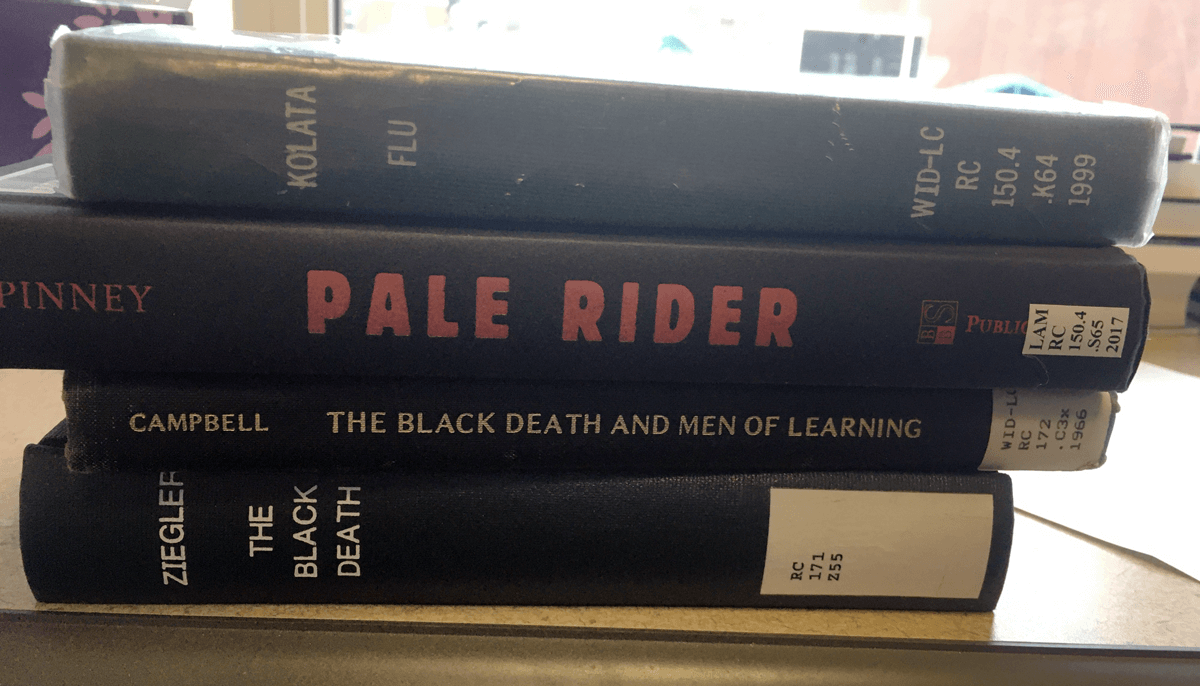
Harvard in a pandemic, even more than in usual times, is a peculiar place.
Other places have runs on hand sanitizer or bottled water. Here people have stocked up on those practical preparedness supplies, too. But here we have also had a run on books, as scholars research relevant precedents to the challenges posed by the novel coronavirus.
The university has three physical copies of Alfred W. Crosby’s America’s Forgotten Pandemic: The Influenza of 1918—one at the Countway library that serves the medical school, one at the Lamont library catering to undergraduates, and one at Widener, the library that makes Harvard’s system the third-largest in the United States, by the American Library Association’s definition. By noon Thursday, all three volumes were checked out, and each had a request—a kind of virtual waiting line for the book once it is returned. That was for the 1989 edition. Hardcovers of a second edition were also gone. A version of the book had been published in 1976 under a different title, Epidemic and Peace, 1918, was also checked out of Countway.
An electronic edition discloses why. Crosby’s afterword, “An Inquiry into the Peculiarities of Human Memory,” is searing. “The important and almost incomprehensible fact about Spanish influenza is that it killed millions upon millions of people in a year or less. Nothing else—no infection, no war, no famine—has ever killed so many in as short a period.”
Yet, Crosby observed, “The average college graduate born since 1918 literally knows more about the Black Death of the fourteenth century than the World War I pandemic.”
One reason, he says, is a gap in history textbooks:
Of the best selling college texts in the United States history, books by such historians as Samuel Eliot Morison, Henry Steele Commager, Richard Hofstadter, Arthur Schlesinger, Jr., C. Vann Woodward and Carl Degler, only one so much as mentions the pandemic. Thomas A. Bailey in The American Pageant gives it one sentence and in that sentence understates the total number of deaths due to it by at least one-half.
Seeking further insight, I strolled through an eerily empty Harvard Yard and into the Widener stacks and the shelves of Lamont, which remain open, at least for now.
An advantage of going to the library in person is a disadvantage of going shopping in person: you leave with things you didn’t know that you wanted when you arrived. Near the books on the 1918-1919 flu epidemic were shelves of volumes about the Black Death, including The Black Death and Men of Learning, by Anna Montgomery Campbell. It looked sufficiently relevant to Education Next’s subject matter as to be worth a closer look.
Campbell reports that “data about elementary schools at this time are scarce.”
She does, though, include an account from the Senate of the Republic of Lucca in 1348, which approved a subsidy of 3 lire a month for “Master Philip, teacher of boys,” explaining, “since, on account of the pestilence that occurred in this year, all the teachers of the boys are dead, and lest the boys in consequence roam about idly, and by their long vacation from teachers become ignorant of letters, they had better come under the teacher’s rod for the virtue of learning.”
Campbell writes that overall the Black Death was a calamity in part because of “mortality among professors and other teachers, involving depreciation in number and calibre.” She notes, though, that “constructive efforts followed in the wake of the plague, and some beneficial changes,” including “endowments of colleges” and “establishments of new universities.”
The founding charters of five universities—three from between 1361 and 1364, one from 1371, and another from 1385—all, according to Campbell, included the same quote from Augustine of Hippo: “nothing is more certain than death, nothing less so than the hour of its coming.”
This is an observation profound enough to live on long past Augustine, who died in 430.
Crosby’s book America’s Forgotten Pandemic: The Influenza of 1918 tells us that an effect of a pandemic is to render Augustine’s insight inescapable even for school-aged children. His afterword concludes with the account of Francis Russell, “who was seven years old in 1918 and lived on top of Dorchester Hill from where he could see Boston….In October the schools closed on account of the flu and he played all day. The mornings were warm and sunny and the crickets sang. One day he and two friends sneaked into the cemetery and watched a funeral. A man with white hair chased them away. Then the boys had a fight and threw rocks at each other.”
Crosby writes: “Francis walked home that evening and along the way became conscious for the first time of the irreversible rush of time. ‘And I knew then that life was not a perpetual present, and that even tomorrow would be part of the past, and that for all my days and years to come I too must one day die.’”
Ira Stoll is managing editor of Education Next.
Read more from Education Next on coronavirus and Covid-19.


